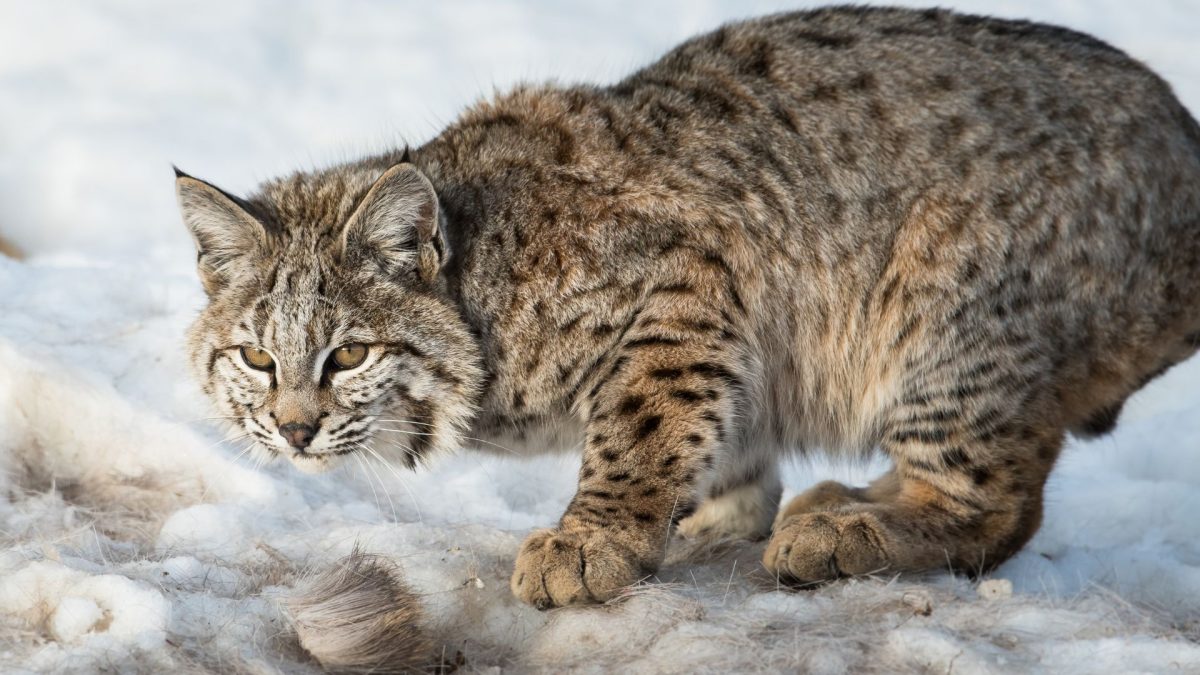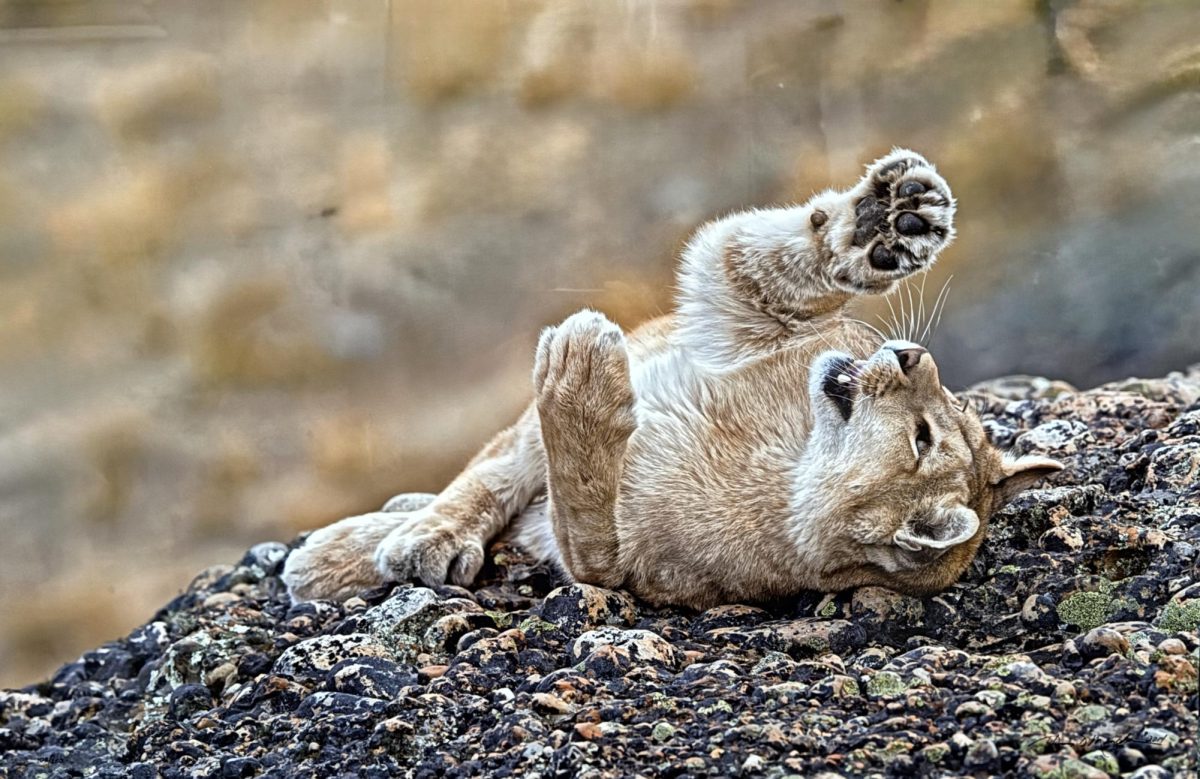It is a cool, winter day in the foothills of the Rocky Mountains. The trees are whispering, and the pale blue sky is oceanic, with the occasional fluffy cloud passing by. The mountain lion’s eyes are a piercing gray-blue that, within an instant, fills with fear. A pack of eight hound dogs chases it for hours on end until the mountain lion is forced up a tree, cowering in the tree with no end in sight. His enormous paws clutch a snow-covered branch, his eyes searching for a way to escape. After pausing and examining the mountain lion, a figure approaches the tree. Is it big enough? — Within seconds, BANG!
In what seems like slow motion, the mountain lion falls nearly 60 feet out of the tree, yowling in pain and feverishly attempting to grasp a branch on his way down before hitting the ground with a deafening thud. The triumphant trophy hunter heaves the mountain lion in the back of a white Ram truck, splattered with dirt and now blood. Every year, 500 big cats, according to Colorado Parks & Wildlife, are killed from November through the end of March.
Approximately 2,500 trophy hunters assault these cats for the sole purpose of displaying them as trophies. The practice of trophy hunting not only causes cruelty to targeted big cats but also puts the dogs involved at considerable risk. Frequently, individuals from across the country hire professional guides to facilitate this activity. These guides employ packs of dogs equipped with GPS trackers to locate and pursue mountain lions. Once a cat is treed, the guide navigates to the location using the GPS signal and then shoots the mountain lion. Frequently, the mountain lions are still alive after being shot and attacked by the dogs; their death is not exactly quick. Subsequently, the hunter often poses with the carcass for a photograph, celebrating their “hard-earned” “trophy.” This method raises significant ethical concerns regarding animal welfare for both the hunted cats and the dogs used in pursuit. In addition to these horrors, every year, 2,000 bobcats are killed through commercial fur trapping. Unfortunately, this involves another animal, the lynx, which is often mistaken for a bobcat and, therefore, in danger as well. These atrocities are only committed for the sake of pride and personal financial gain.
Trophy hunting differs from subsistence hunting. Subsistence hunting can be defined as harvesting wildlife for survival. Many people in societies around the world still rely on wildlife for food, clothing, income, and cultural identity, or, in rare cases, self-defense is acceptable. Julie Marshall, the director of public relations for this campaign, assures that “your risk of conflict is zero when you take the right precautions. If one’s family’s livelihood is farm stock animals, they will do what is needed to defend against predators. According to Boulder County Parks & Open Space, mountain lions prefer solitude and are generally timid, thus leading a self-sufficient life. These solitary creatures hunt independently and care for their young, requiring only a suitable habitat to thrive. Trophy hunting is not subsistence hunting, which, when conducted humanely and responsibly, serves a legitimate purpose. While some view any form of animal killing as cruel, personal opinions on this matter vary. However, such tolerance certainly should not extend to trophy hunting.
Wayne Pacelle the architect for the Cats Aren’t Trophies campaign. With his extensive knowledge and experience in the advancement of animal rights, Pacelle emphasizes the ethical imperative to protect native wild cats from unnecessary harm. Pacelle states, “The principal effect would be a legal protection for mountain lions, bobcats, and Canada lynx,” making clear the campaign’s goals: To end trophy hunting for good within Colorado. In Pacelle’s eyes, trophy hunting is “a profound moral failing of humanity.” Is it ethically justifiable to kill an animal that poses no threat whatsoever and would remain harmless if left undisturbed? This question challenges one to reflect on the moral implications of trophy hunting, even if one does not personally agree with the premise.
In addition, one must realize the problematic power dynamic between animals and humans. Humans hold all of the power. The technology and innovations at our disposal are a danger to every animal species on this planet. Pacelle says, “It’s a question of human responsibility. How do we handle this immense power that we have? We have a choice to be merciful or to be cruel and kill and hurt animals in so many ways.” For example, one of the most abundant birds was the passenger pigeon. There were billions. They were then exterminated by shooters in 1914. So in the latter part of the 20th century, passenger pigeon populations went from billions to zero. This is one of many instances where humans have wiped out healthy and abundant species to either shocking low numbers to none.
Mountain lions also play a crucial role in maintaining the delicate balance of Colorado’s ecosystems, particularly the terrible disease that afflicts deer, elk, and moose. This chronic wasting disease has no cure and remains active in the environment after an infected animal’s death, making it highly transmissible. Remarkably, mountain lions target and consume infected prey, and their digestive systems deactivate the disease-causing prions, preventing further transmission. This is one of the many reasons why Proposition 127 must pass. Opponents of Prop 127 suggest that, without trophy hunting, the lions would overpopulate and cause conflicts. This is, in fact, completely incorrect. Mountain lion populations are regulated by prey availability (primarily deer and elk) and sufficient habitat. The notion that trophy hunting is an effective management tool for these populations is misguided and scientifically incorrect. What’s worse is that nearly half of the mountain lions that are shot are female. If the mother is killed, all the kittens are doomed to die. So add about another 1,000 kittens who will also die as a consequence. Trophy hunting disrupts natural population dynamics and ecological relationships within the affected regions.
Furthermore, Proposition 127 has gathered significant endorsements from notable figures. Dr. Jane Goodall, the renowned primatologist and conservationist, has expressed her support, stating that these animals deserve protection as they too have the ability to feel pain as much as humans do. Former U.S. Fish and Wildlife Service Chief Dan Ashe has also announced his support along with 20 other wildlife scientists signed a letter saying to vote yes on Proposition 127 because trophy hunting is simply pure cruelty.
Wayne Pacelle is a prominent animal welfare advocate who leads two organizations: Animal Wellness Action, which focuses on policy changes and public education, and the Center for a Humane Economy, which influences businesses and consumers to make animal friendly choices. His leadership has significantly advanced animal welfare causes in the US and internationally.
As a young and influential demographic that will experience the direct effects of political decisions, it is essential for a high school student to take action. Julie Marshall, the public relations director for the Cats Aren’t Trophies campaign, highlights that “the most important thing that high schoolers can do besides vote is go home and share with their family, friends, and the surrounding community about what they have learned.” Another way to support Prop. 127 is by volunteering for canvassing—either door-to-door or through phone banking—or by donating to the cause. The ethical and ecological evidence clearly demonstrates that mountain lions play a vital role in maintaining healthy ecosystems. These apex predators help control prey populations, protect biodiversity, and contribute to the overall balance of nature.
Ultimately, the choice to coexist with mountain lions and protect their habitats rests with us. I implore readers to speak to family members and friends, especially those of voting age, and urge them to vote YES on Prop 127. By making informed decisions and implementing responsible conservation measures, we can ensure the survival of these magnificent animals and preserve the delicate balance of the natural world we share.




